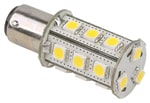
led_ba15d_tower_150_3097.jpg
A few days ago I received an email asking about the use of the new LED replacement bulbs in navigation light fixtures. The query came in from the general manager of a high-end, full service boatyard on Chesapeake Bay. This manager was concerned that there may be a problem with the use of these bulbs as it might have the potential to alter the characteristics of the navigation lights. You see, navigation lights are required under Federal law to meet established criteria for color, range of visibility and arc of visibility. The querie came in over the weekend and I was busy at the Miami Boat show so I didn’t get to answer the question immediately. One of my colleagues at the ABYC did however and I have to share as well as supplement his answer because it is important information that needs to get out to everyone.
The bulbs in question are available from a few different sources and are direct replacements for either the socket type or bayonet type bulbs commonly used. They look like the photo you see here, the socket type is shown.

Now the quirk here is that these bulbs are cataloged as being direct replacements for the light bulbs in the navigation light fixtures. But, and this is an important but, the catalog also contains a disclaimer that few probably read that can have serious legal implications in the event of an accident where use of poper navigation lights may be a question. My colleague Dante from the ABYC technical department provided a solid explanation here:
“An LED array with the base of a bulb designed for retrofit into an existing light fixture has filtrated the automotive and marine industries. The bottom line is the optics in the existing lamp assembly were not intended for the LED’s unique light pattern. Even if the retrofitted LED physically fits and illuminates, it may put too much light (or not enough light) where it is needed for a navigation light to work properly. Or create blotchy light pattern that may appear have a flashing effect at distance as the boat rotates relative to the viewer. The retrofitted LED and existing lamp assembly were not color tested together, something that is specified in detail in ABYC Standard A16. Nor were they heat tested, which is concern for LEDs as their light output and life decrease with heat. The retrofitted LED into a incandescent housing has more points of failure than the simple bulb or a properly designed LED system.”
Several years ago I was involved as a professional examiner to inspect a boat that had been crashed into and one of the folks on board had been killed as a result of the accident. The question being asked centered around whether or not the stern light on the vessel was operational at the time of the accident, one in which a following boatload of July 4th revelers had run right into and up onto the deck of the lead boat. The claim was that the boat that ran into the one I inspected had not seen the lead boat because the stern light was not operational. I determined that the stern light could not have been operational due to the way it had been wired.
The boat with no stern light lost out on their claim for damages, even though one of the members of that party died.
You get the idea here. In spite of the overwhelming benefits of using LED’s, low current draw and long life, they MUST be purchased as a light assembly that has been tested as a unit. That means replacing the whole fixture, not just the bulb.







